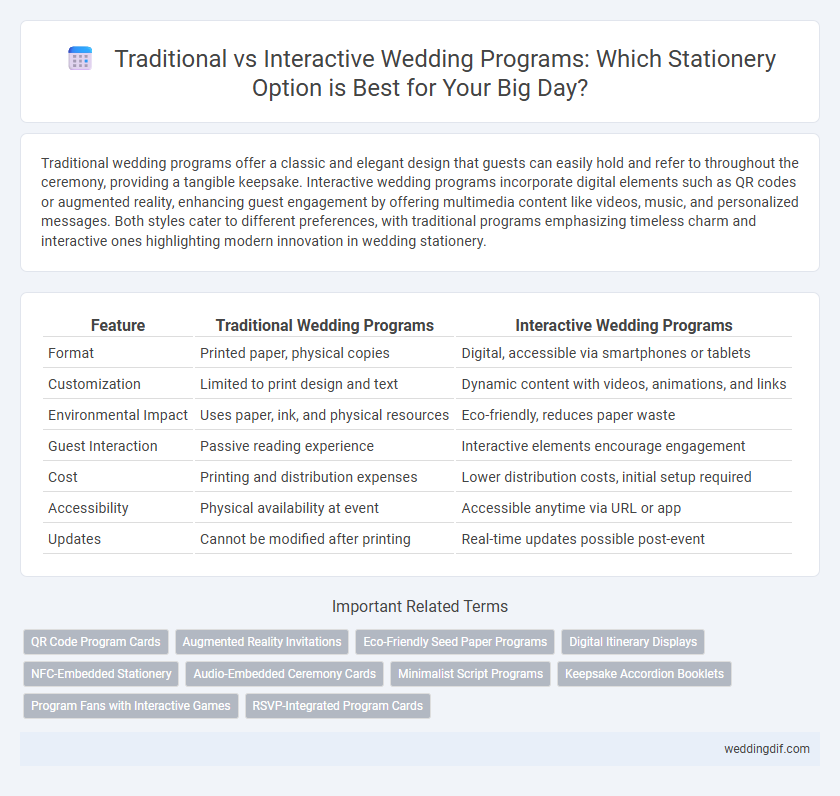Traditional wedding programs offer a classic and elegant design that guests can easily hold and refer to throughout the ceremony, providing a tangible keepsake. Interactive wedding programs incorporate digital elements such as QR codes or augmented reality, enhancing guest engagement by offering multimedia content like videos, music, and personalized messages. Both styles cater to different preferences, with traditional programs emphasizing timeless charm and interactive ones highlighting modern innovation in wedding stationery.
Table of Comparison
| Feature | Traditional Wedding Programs | Interactive Wedding Programs |
|---|---|---|
| Format | Printed paper, physical copies | Digital, accessible via smartphones or tablets |
| Customization | Limited to print design and text | Dynamic content with videos, animations, and links |
| Environmental Impact | Uses paper, ink, and physical resources | Eco-friendly, reduces paper waste |
| Guest Interaction | Passive reading experience | Interactive elements encourage engagement |
| Cost | Printing and distribution expenses | Lower distribution costs, initial setup required |
| Accessibility | Physical availability at event | Accessible anytime via URL or app |
| Updates | Cannot be modified after printing | Real-time updates possible post-event |
Understanding Traditional Wedding Programs
Traditional wedding programs are printed booklets that outline the order of the ceremony, including readings, music, and participants, providing guests with a clear and elegant guide. These programs often feature classic designs, high-quality paper, and formal typography to match the wedding theme, enhancing the overall aesthetic experience. Understanding traditional wedding programs highlights their role in preserving ceremony structure and offering a tangible keepsake for attendees.
Exploring Interactive Wedding Programs
Interactive wedding programs enhance guest engagement through digital features like QR codes, videos, and customizable content, creating memorable and personalized experiences. Unlike traditional printed programs, interactive options offer real-time updates and eco-friendly benefits by reducing paper use. These modern wedding stationery solutions blend creativity with technology, making ceremonies more dynamic and accessible for all attendees.
Key Elements of Classic Program Designs
Classic wedding programs typically emphasize elegant typography, structured layouts, and high-quality paper to convey a timeless aesthetic. Key elements include clear sections for the order of service, bridal party names, and venue details, often adorned with subtle motifs or borders reflecting the wedding theme. These designs prioritize readability and formal presentation, contrasting with the dynamic features found in interactive digital programs.
Benefits of Interactive Wedding Stationery
Interactive wedding programs enhance guest engagement by incorporating digital features such as QR codes, videos, and personalized messages, creating a memorable and dynamic experience. These programs offer customizable options that accommodate real-time updates and eco-friendly distribution, reducing paper waste associated with traditional stationery. Guests appreciate the convenience of accessing detailed event information and interactive elements directly from their smartphones, fostering a more connected and informed celebration.
Comparing Printing Methods for Both Styles
Traditional wedding programs typically use offset printing or digital printing methods that produce high-quality, crisp text and vibrant colors on heavier cardstock, ensuring durability and a classic appearance. Interactive wedding programs often incorporate digital printing combined with augmented reality (AR) or QR codes, allowing guests to access dynamic content such as videos or personalized messages via smartphones, merging physical cardstock with digital experiences. Both printing methods require precise color calibration and material selection to maintain visual appeal, but interactive programs demand additional technology integration which can increase production complexity and cost.
Guest Engagement: Traditional vs Interactive
Traditional wedding programs typically provide a static overview of the ceremony details, offering minimal guest interaction or engagement beyond reading. Interactive wedding programs incorporate elements such as QR codes, personalized messages, and multimedia content, enhancing guest participation and creating a memorable experience. Studies show that interactive programs increase guest attention and involvement by over 40%, making them a preferred choice for modern wedding stationery.
Customization Options for Each Program Type
Traditional wedding programs offer limited customization options, typically focusing on paper type, font style, and basic color schemes. Interactive wedding programs enhance personalization by integrating digital elements such as QR codes, video messages, and clickable timelines, allowing guests to engage deeply with the event details. Both options provide unique customization levels, but interactive programs deliver a dynamic and immersive experience beyond static design choices.
Budget Considerations: Paper vs Digital
Traditional wedding programs typically require higher costs due to printing, quality paper choices, and intricate designs, impacting the stationery budget significantly. Interactive digital wedding programs offer a cost-effective alternative by eliminating printing expenses while providing customizable, multimedia elements that enhance guest engagement. Choosing between paper and digital programs involves weighing upfront material costs against potential savings and the value of an immersive, eco-friendly experience.
Eco-Friendliness and Sustainability Factors
Traditional wedding programs often use glossy, laminated paper that is less eco-friendly due to its non-recyclable nature and chemical coatings, contributing to landfill waste. Interactive wedding programs leverage digital platforms or biodegradable materials, significantly reducing paper usage and environmental impact while enhancing guest engagement. Choosing interactive options aligns with sustainability goals by minimizing resource consumption and promoting eco-conscious celebrations.
Choosing the Right Program Style for Your Wedding
Traditional wedding programs offer a timeless, elegant design with a clear layout that guests can easily follow during the ceremony. Interactive wedding programs incorporate multimedia elements such as QR codes, videos, or personalized messages, enhancing guest engagement and creating a memorable experience. Selecting the right wedding program style depends on your wedding theme, guest preferences, and desire for either classic sophistication or modern interactivity in your stationery.
Traditional Programs vs Interactive Wedding Programs for Stationery Infographic

 weddingdif.com
weddingdif.com